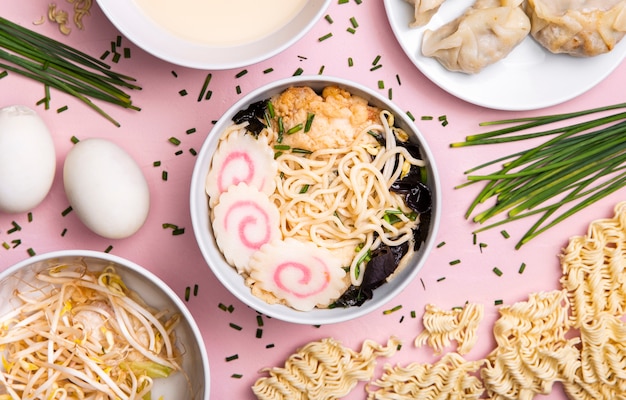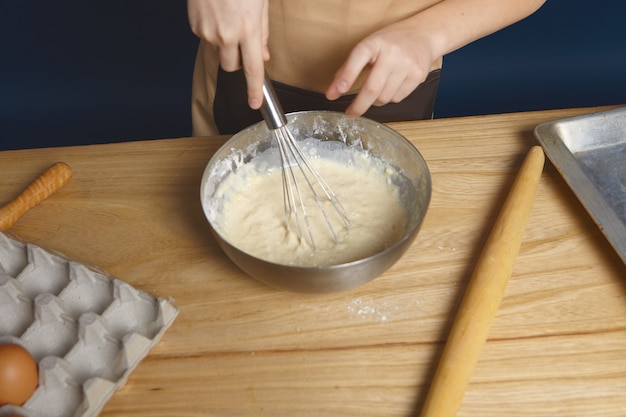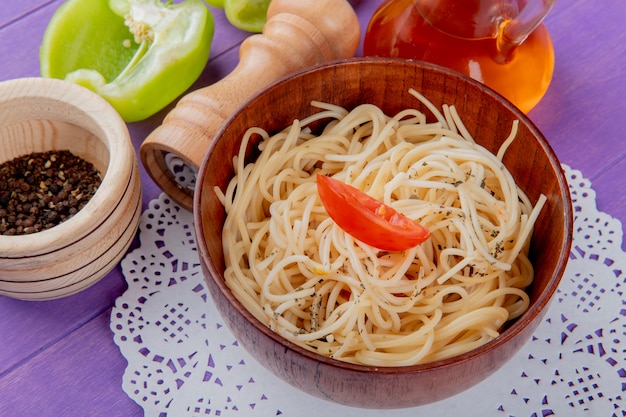rice noodles are a staple in my kitchen, and I reckon they are in many others. You can use them in everything from stir-fries and soups to salads and even desserts. But let’s be honest, cooking rice noodles can be a bit of a puzzle. Sometimes they come out mushy, other times they’re dry as a bone. But fear not! After years of trial and error (and a fair bit of burnt noodles), I’ve finally cracked the code to perfect rice noodles. This guide is your ultimate resource to transforming those skinny strands into a culinary masterpiece.
Part 1: Understanding the Basics

The Different types of rice Noodles
Let’s face it, the world of rice noodles can be a bit overwhelming. There are so many different types, it’s enough to make your head spin. But don’t fret, I’m here to simplify things for you.
- Flat Rice Noodles (Banh Pho): These are the most common type of rice noodle, and they’re perfect for soups and stir-fries. Think of those beautiful, thin, flat noodles you find in a steaming bowl of pho, swimming in broth, herbs and a touch of chilli. That’s the magic of flat rice noodles - they’re light, they absorb all those delicious flavours, and they have a slight chew that’s just right.
- Round Rice Noodles (Banh Can): These are the ‘skinny’ cousins of flat rice noodles. They’re round, springy and usually used in salads or stir-fries. They’re a staple in many Thai and Vietnamese dishes, adding a delightful crunch and a touch of elegance.
- Rice Vermicelli (Banh Hoi): These are the slimmest of the bunch, and they’re perfect for salads and spring rolls. They’re known for their delicate flavour and their ability to soak up all the delicious sauce. Imagine those thin strands coated in a rich peanut sauce or a sweet and tangy dressing - pure bliss!
- Rice Sticks (Banh Cuon): These are thicker and more cylindrical, and they’re often used in Vietnamese pancakes or steamed dishes. They have a slightly chewier texture compared to other types, making them perfect for dishes that require a little more bite.
There are a few more variations, but these are the main players. As you can see, there’s a perfect noodle for every dish, from the humble pad thai to the elegant Vietnamese pho.
What Makes Rice Noodles Unique?
Rice noodles are made from rice flour, water, and sometimes tapioca starch. They’re naturally gluten-free, making them a fantastic option for people with gluten sensitivities. One of the best things about rice noodles is their neutral flavour. They don’t come with their own strong flavour profile, so they perfectly absorb the flavours of whatever you’re cooking them with. Plus, they cook really quickly, which is a lifesaver when you’re short on time.
But let’s be honest, the real star of the show is the texture. Rice noodles have this delicate texture that's not too firm and not too soft. They have this slightly chewy, springy quality that's just so satisfying. It's like a dance on your tongue - they give a little bit of resistance, then they melt away, leaving you wanting more.
Part 2: Cooking the Perfect Rice Noodles

Soaking and Preparing
Before we dive into the actual cooking, let's talk about the crucial step of soaking the rice noodles. I know it might seem like a hassle, but trust me, it’s the key to achieving that perfect texture. The soaking process helps to soften the noodles and prevent them from becoming too sticky or mushy. It also allows them to absorb flavours more effectively. Here’s how I do it:
- Find a large bowl: You need a bowl big enough to comfortably hold the noodles without them being cramped. You want them to have room to breathe and soak evenly. It’s also a good idea to use a bowl that’s not too deep, so the noodles can absorb the water evenly.
- Fill with cold water: Make sure the water completely covers the noodles. Don’t be shy, go for plenty of water! You can use tap water, or if you prefer, use bottled water.
- Soak for the right amount of time: This is where you need to pay attention to the instructions on your package. It’s important to soak them for the right amount of time, usually between 15 to 30 minutes. If you soak them for too long, they will become mushy, and if you soak them for too short a time, they will be tough. I always err on the side of caution and soak them for a little longer, just to be sure.
- Drain the water: Once the noodles are soft, drain the water thoroughly. You can use a colander or simply pour the water out of the bowl.
You can also soak the noodles in warm water. Just remember to adjust the soaking time accordingly. Soaking in warm water will soften the noodles faster. I typically soak them in warm water for about 10 to 15 minutes. Just be careful not to soak them for too long, as they can become mushy.
You can also skip the soaking step altogether, especially if you’re using dried rice noodles. Just be aware that they will take longer to cook.
cooking rice noodles
Now that your noodles are ready, let's talk about cooking them. I’ve found that there are a few tried-and-true methods. Here’s my preferred method:
- Bring a pot of water to a boil: Don’t worry about being too precise with the measurements. A large pot of water is all you need.
- Add the noodles: Gently add the soaked noodles to the boiling water. Don’t overcrowd the pot; give those noodles some space to cook evenly.
- Cook for a few minutes: The noodles will cook quite quickly, usually within 1 to 3 minutes. I like to check them after a minute and then cook for another minute or two. The perfect texture is slightly al dente, with a slight chew to them.
- Drain the noodles: Once the noodles are cooked, drain them in a colander. It’s a good idea to rinse them with cold water to stop the cooking process and prevent them from sticking together.
Another good option is to cook the noodles in broth instead of water. This will add extra flavour to your noodles. You can also cook them in a wok or a large frying pan. Just make sure to use plenty of water or broth to cover the noodles.
Tips for Perfect Noodles
Here are a few tips that I’ve learned over the years to make sure your rice noodles are always perfectly cooked:
- Don't overcook the noodles: This is the number one mistake people make. Overcooked noodles will become mushy and lose their texture. Keep a close eye on them and remove them from the water as soon as they’re cooked. Think of it like pasta - you want them to have a slight bite to them.
- Don't overcrowd the pot: If you add too many noodles to the pot, they won't cook evenly. Add them in batches if necessary.
- Use a good quality pot: A good pot with a thick bottom will help to distribute the heat evenly and prevent the noodles from sticking to the bottom.
- Don't rinse the noodles if you're using them for stir-fries: Rinsing the noodles will remove the starch, which helps to create a sauce that coats the noodles. So, keep that starch if you’re making a stir-fry.
- Keep the noodles warm: Once the noodles are cooked, keep them warm by placing them in a colander over a pot of simmering water. This will prevent them from getting cold and dry.
Part 3: Using Rice Noodles in Dishes

Stir-fries
Rice noodles are a natural star in stir-fries. They absorb all the delicious flavours of the sauce and veggies, creating a symphony of taste and texture. They add a lovely lightness to the dish, so you don’t feel weighed down after a big plate of stir-fry goodness. When cooking stir-fries, it’s important to make sure that the sauce is thick enough to coat the noodles. If it's too thin, the noodles will become mushy. You can thicken the sauce by adding cornstarch or arrowroot powder.
Soups
Rice noodles are a delightful addition to soups, adding a chewy texture and a touch of elegance. They work well in both hot and cold soups. When adding rice noodles to soup, you can cook them directly in the soup broth, or you can soak them separately and then add them to the soup at the end. If you cook them in the soup broth, be sure to add them towards the end of the cooking time. They cook quite quickly and will become mushy if they’re overcooked.
Salads
Rice noodles add a great textural element to salads. You can use them in both cold and warm salads. For cold salads, you can soak the noodles in a dressing or simply toss them with a light dressing. For warm salads, you can cook the noodles separately and then add them to the salad. A classic example is a Vietnamese noodle salad with fresh herbs, crunchy vegetables and a tangy dressing. It’s a real crowd-pleaser.
Other uses
Rice noodles are incredibly versatile and can be used in a variety of other dishes. I’ve even used them in desserts like rice noodle pudding, which is surprisingly delicious. You can also use them to make spring rolls, dumplings, and even rice noodle cakes. The possibilities are endless.
Part 4: Tips and Tricks from My Kitchen
Now let's talk about some of my personal tips and tricks. I’ve picked up some tricks along the way, you know, the little things that make a big difference.
Use the right cooking method
One of the biggest mistakes people make is using the wrong cooking method for their rice noodles. Some noodles are designed to be cooked in boiling water, while others are designed to be soaked in water. Always check the instructions on the package to make sure you’re using the right method. I’ve tried those fancy electric noodle cookers, but there’s something about boiling them in a big pot that feels more authentic.
Add a splash of vinegar
Adding a splash of vinegar to the boiling water can help to prevent the noodles from sticking together. It also helps to brighten the flavour of the noodles. I always keep a small bottle of rice vinegar handy in my kitchen. It makes a world of difference.
Don't be afraid to experiment
Rice noodles are so versatile, you can really experiment with different flavours and textures. Try using them in different dishes, add different sauces and toppings. You might even discover a new favourite dish. I once made a pad thai with mango and chilli, and it was amazing.
Part 5: Storage and Shelf Life
Now, let’s talk about storing those precious noodles. I know you’ve got a lot of rice noodle recipes planned, and I want to make sure you get the most out of them.
Storing Uncooked Rice Noodles
Uncooked rice noodles can be stored in a cool, dry place for up to a year. You can store them in their original packaging or transfer them to an airtight container. Just make sure the container is clean and dry.
Storing Cooked Rice Noodles
Cooked rice noodles can be stored in the refrigerator for up to 3 days. It’s best to store them in an airtight container, so they don’t dry out. To reheat them, you can microwave them, steam them, or stir-fry them. Just remember that they will not be as good as fresh cooked noodles, but they’re still pretty tasty.
Freezing Rice Noodles
You can also freeze rice noodles for up to 3 months. It’s best to freeze them in an airtight container or freezer bag. To thaw them, you can place them in the refrigerator overnight. Once they are thawed, you can cook them as usual.
Part 6: Common Mistakes to Avoid
Overcooked Noodles
This is the most common mistake. Overcooked noodles will become mushy and lose their texture. Always check the noodles before you take them out of the boiling water. They should be slightly al dente, with a slight chew to them. If they're too soft, they're overcooked.
Undercooked Noodles
On the other hand, undercooked noodles will be tough and chewy. Make sure to cook them long enough, but not too long. You'll need to cook them until they are soft but still have a bit of bite to them.
Not Soaking Noodles Properly
Soaking the noodles is crucial. If you don’t soak them long enough, they will be tough. If you soak them for too long, they will become mushy. Always check the instructions on the package and follow them carefully. You’ll thank me later.
Using Too Much Water or Broth
When cooking rice noodles, it’s important to use just enough water or broth to cover the noodles. If you use too much, the noodles will become mushy and watery.
Not Rinsing Noodles
Rinsing the noodles after cooking can help to prevent them from sticking together. It also helps to remove excess starch, which can make the noodles sticky.
Part 7: Variations and Substitutions
Gluten-Free Options
Rice noodles are naturally gluten-free, so they are a great option for people with gluten sensitivities. If you need a gluten-free alternative, you can also try using rice paper or mung bean noodles. They have a similar texture and flavour to rice noodles.
Other types of noodles
If you want to experiment with different flavours and textures, you can also try using other types of noodles. Some popular alternatives include:
- Egg noodles: These noodles are made with wheat flour and eggs. They have a slightly richer flavour than rice noodles and are a good option for stir-fries and soups.
- Wheat noodles: These noodles are made with wheat flour and water. They have a more substantial texture than rice noodles and are a good option for stir-fries and soups.
- udon noodles: These noodles are thick and chewy, and they are made with wheat flour. They’re a popular choice for Japanese noodle dishes like udon soup.
- Ramen noodles: These noodles are made with wheat flour, salt, and kansui (an alkaline solution). They are often used in ramen soup.
The world of noodles is vast and varied, so feel free to experiment and find your perfect match.
Part 8: FAQs
1. What are the best rice noodles for stir-fries?
I find flat rice noodles (banh pho) or round rice noodles (banh can) are excellent for stir-fries. They have a good texture and they absorb the flavour of the sauce well, making every bite a delightful experience.
2. Can I use rice noodles in a soup?
Absolutely! Rice noodles are a fantastic addition to soups, adding a wonderful textural element and a touch of elegance. Just make sure to add them towards the end of the cooking time, as they cook quickly.
3. What happens if I overcook rice noodles?
Overcooked rice noodles will become mushy and lose their texture. You’ll end up with a sad, soggy mess. If you’re not sure if they’re cooked, it’s better to err on the side of caution and take them out of the water a little early. You can always cook them for a little longer if necessary.
4. How do I prevent rice noodles from sticking together?
The key is to rinse them with cold water after cooking. This will help to stop the cooking process and prevent them from sticking together. You can also add a splash of vinegar to the boiling water when cooking them.
5. Can I freeze cooked rice noodles?
Yes, you can freeze cooked rice noodles. Just make sure to store them in an airtight container or freezer bag. They will last in the freezer for up to 3 months. To thaw them, you can place them in the refrigerator overnight. Once they are thawed, you can cook them as usual.
Final Thoughts
There you have it! My ultimate guide to perfect rice noodles. It’s been a journey of experimentation, burnt noodles, and a few mishaps along the way, but I’m so happy to share my discoveries with you. Remember, the key is to have fun and experiment with different flavours and textures. Whether you’re making a classic pad thai or a creative noodle salad, rice noodles are a versatile and delicious addition to any dish.
Everyone is watching

How to Cook Frozen Lobster Tails Perfectly: A Step-by-Step Guide
RecipesLobster. Just the word conjures up images of lavish meals, special occasions, and a taste of luxury. But let's...

Pigs in a Blanket Cooking Time: How Long to Bake for Perfect Results
RecipesAh, pigs in a blanket. Just the name conjures up images of those delightful little parcels of crispy pastry en...

Pork Fillet Cooking Time: How Long to Cook It Perfectly
RecipesPork fillet, or tenderloin as it's sometimes called, is a real favourite in our house. It's so versatile, and...

The Ultimate Guide to Tender, Juicy Pulled Pork
RecipesRight, let's talk pulled pork. It's one of those dishes that just screams "comfort food," doesn't it? I mean...

The Ultimate Guide to Cooking Sweet Potatoes: From Roasting to Mashing
RecipesSweet potatoes. Just the name conjures up images of warm, comforting dishes, bursts of vibrant color, and a to...
